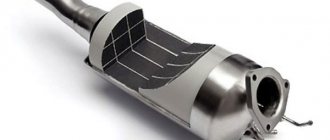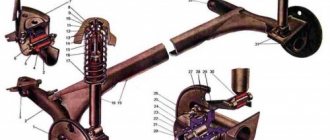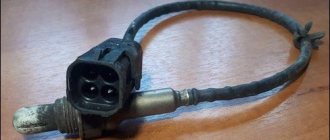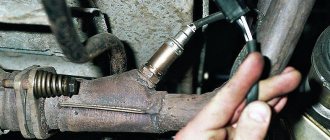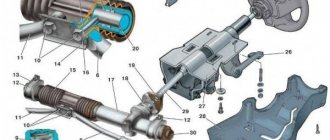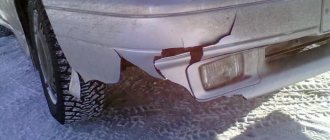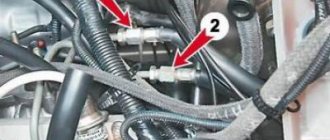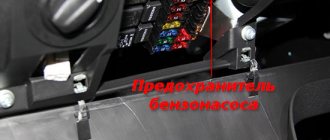After buying the car, I decided to get rid of the catalyst, since it tends to get clogged and replacing it is not cheap. Previously, on cars they stood where the resonator is and such a catalyst costs 3,000 thousand rubles. And now they have started to install them on the exhaust manifold (spider, pants, in general, whoever likes it more) and such a catalyst costs almost 10,000 thousand. Well, why do you need one like that, I thought and bought myself a replacement insert - a 4-1 spider from Stinger. The spider itself
I thought for a long time whether to change it at the service center or change it myself, because there is nothing complicated, and the service center will take a lot of money, so I decided to do this during the holidays. I arrived at the dacha, made myself a mini overpass to make it easier to get under the car, and then started disassembling it.
I dismantled almost half the car to get to this catalyst, removed the intake manifold, unscrewed all the hoses, screwed all the intake and exhaust manifolds with 13 nuts, so there are at least 30 of them screwed in there. When I got to the catalyst, I was thinking, will I put it all back together and won’t I have anything left over, as always? In general, an hour later I got to him and took off
Here it is in comparison with the new spider
Putting the whole thing back together, the work took about three hours. According to the first sensations, the car began to accelerate faster and the consumption was on average per 100 km. became 6.5-7 liters, but did not notice any significant changes. But what does the catalyst itself consist of?
Even after installation, the wire that comes from the lambda probe was a little short and I decided to fix this problem and make an extension cord, for this I bought two connectors (male/female) and twisted them together
Oh yes, after installing the spider, the check on the tidy lights up very rarely, almost never lights up and the on-board computer writes an error that the neutralizer is weak. I’m thinking about doing chip tuning, but somehow I have doubts, the consumption will increase at the same time, who will say anything about this, is it worth it or not?
Replacing the catalyst on a VAZ 2115 with your own hands
Catalyst for VAZ 2115
Every owner of a “tag” is once faced with a catalyst problem. And then he needs an urgent replacement of the catalyst on the VAZ 2115.
An old muffler often even sags so low that it clings to everything that lies incorrectly on the road surface. Of course, you can use fixing straps or wire, but this will not help.
In any case, the VAZ 2115 catalyst needs to be replaced.
OUR CENTERS ON THE CITY MAP
Do you want to inexpensively replace the catalyst with a VAZ 2115 flame arrester? “MSK Muffler” is an urgent replacement of catalytic converters for Lada 2115 with a 1-year warranty.
What is a catalytic converter
The exhaust system catalyst is the most expensive part of the muffler, the main function of which is to clean the exhaust gases from harmful impurities. The average service life of these components is approximately 120-150 thousand kilometers. The design of the catalyst consists of ceramic or metal “honeycombs” that act as a reusable filter.
Signs of breakdown of the VAZ 2115 catalyst
- difficulty starting the engine, and in more serious cases, the inability to start the engine;
- noticeable loss of power from the power plant;
- increased fuel consumption;
- Check Engine Light Signal
The main reason for premature failure of the catalytic converter is the low quality of the fuel used. The proposed price of a catalyst for imported cars starts from 30 thousand rubles.
Therefore, experts often suggest replacing the catalyst with a cheaper flame arrester. For diagnostics, the catalyst must be dismantled - there is no other way to accurately determine the integrity of this part. Methods such as checking the level of emissions of harmful substances and measuring the pressure at the outlet do not always allow accurate conclusions to be drawn.
Installing a flame arrester - advantages and disadvantages
A flame arrester is an analogue of a resonator, the main task of which is to reduce the noise level and temperature of the exhaust gases. The advantages of flame arresters can be listed as follows:
- relatively low cost;
- lack of response to low-quality fuel;
- a slight increase in engine power compared to a running catalyst;
Installing a flame arrester is characterized by the following disadvantages:
- lack of exhaust gas cleaning function;
- increased load on subsequent parts of the exhaust system
In order for this operation to be successful, we recommend that you purchase branded flame arresters, which are characterized by high operating efficiency and a long service life.
Our specialists will definitely advise you on the optimal models, and if necessary, the required part will be quickly delivered to the repair station. To find out how much it costs to replace a catalyst with a flame arrester, call our car service center at the phone number listed on this website.
WHY DO YOU NEED A CATALYST?
Usually, when it comes to a catalyst, most motorists only think of a muffler, or rather a can or pipe. In fact, the exhaust system of a car includes several elements: connecting pipes, muffler, resonator, corrugation, catalyst, etc. So:
- The catalytic converter, as the catalyst is called, is a fairly important element of the car and the entire exhaust system.
- One of the main functions assigned to it is the purification of exhaust gases that flow through the pipe. The latest Euro 2 standards require the presence of a catalyst in the exhaust system of the car and a special oxygen sensor.
- The neutralizer itself, despite the fact that it is made of metal and a massive body, is a rather fragile element. He is afraid of severe mechanical damage, and is also quite sensitive to low-quality fuel. Impurities and various dirt residues contained in low-quality gasoline remain on the walls of the catalyst, gradually accumulate there and lead to damage to the part. In Russian conditions, the catalyst fails very quickly. And if, usually, it is designed for 200,000 km of run, then if it comes into daily contact with Russian fuel, it will not withstand even 30,000 km of run.
It is useful to know what a catalytic converter is made of. And find out how this part works. As was said, it reduces the amount of harmful substances and impurities that any car with an internal combustion engine emits into the surrounding atmosphere. These are substances dangerous to human health, such as carbon monoxide, nitrogen oxide, etc.
For example, carbon monoxide is a real gas that has neither color nor odor. But it is precisely this that contributes to the appearance of cardiac colic and headaches in people.
As for the design of the catalyst, it consists of a ceramic or often metal honeycomb part. Why honeycombs?
Yes, because the design resembles a honeycomb. On top of these same honeycombs, special precious metals, most often platinum, are sprayed.
Although palladium catalysts are often used in the automotive industry of developed countries.
Palladium catalyst
Repair and replacement of the neutralizer
Replacing the catalyst in a VAZ 2115 is carried out only after analyzing the peculiar sounds emitted by the exhaust system. It may also be an unusual smell or color of the exhaust gas. Common symptoms of a faulty catalytic converter include a rattling sound, like scraping metal, coming from underneath the car. In such cases, it is urgently necessary to replace it with a new catalytic converter or a homemade flame arrester, which copes well with the basic functions of the factory catalyst.
The right tool
For work we will need a set of tools:
- spanners;
- screwdrivers;
- mount;
- jack.
Attention: The inspection hole is a mandatory element of the work process, onto which the car must be lifted. Although in some cases drivers use a regular lift.
Removing the catalyst
So, let's start:
- lift the car onto a pit or jack;
- unscrew the bolts securing the converter to the exhaust pipe;
- remove the bolts together with the springs, using a 13mm wrench;
- take a screwdriver with a wide blade and pry off the graphite-containing O-ring;
- remove it;
- proceed to unscrewing the rear mounting bolts (there are also two of them);
- to unscrew, use a 17mm wrench;
- when unscrewing and removing the nuts, hold the bolt from turning with another 17 wrench;
- remove the neutralizer.
In this video you can see everything with your own eyes
Making a homemade flame arrester
The catalyst has been removed. Now it's time to think about what to replace it with. It is clear that all technical parameters of the system and environmentally friendly exhaust must be retained. By removing the faulty catalyst from the system, we maintain normal dynamics and save approximately two liters of fuel per hundred kilometers. But this is the case, everything will work if you put something instead of the catalyst. And humanity has not yet come up with anything better than a homemade flame arrester (photo above) (a new catalyst is expensive, and as was said, on Russian roads it behaves like an English gentleman in a white tailcoat). Making a flame extinguisher with your own hands is no longer a novelty. Even a novice motorist can handle this task; he just needs to follow these step-by-step instructions. If you don’t want to get dirty or waste time, then any car service will undertake to make the flame arrester that is needed but, of course, will charge a good price for it. In order to begin work on the manufacture of a flame arrester, it is useful to learn a little about the principle of its operation. In general terms, according to the instructions, it is similar to the operation of the catalyst itself, but the only difference lies in the direct-flow design that distinguishes the flame arrester. Flows of exhaust gases do not linger in it, thereby preventing impurities, which are rich in low-quality fuel, from settling. Flame arrestors are also sold in stores, but finding one that would be ideal for your car will not be easy. And the price for them is not cheap. Therefore, doing it yourself will come in handy. We prepare the necessary tools and parts:
- welding machine;
- two metal pipes having different cross-sectional diameters;
- metal brush and sponge - 10 pieces.
Begin:
- take a pipe that matches the size of the exhaust;
- we make small holes in it along the entire length (about 5-6 millimeters);
- insert this pipe into another one with a larger diameter;
- combine the centers and weld one of the edges;
- stretch metal sponges;
- We take a metal rod and tamp the washcloths inside the flame arrester pipe (we do this carefully and try to insert the washcloths deeper);
- after filling the pipe completely with metal brushes, you need to weld the second end of the pipe around the circumference (at the same time, first bend the edges of the pipe);
- install a flame arrester in the exhaust system.
At this point we finish installing the flame arrester, but continue to modernize the exhaust system. As you know, there is always a special oxygen sensor on the catalyst. It's called a lambda probe. And almost always, if the catalyst deteriorates, the lambda probe also needs to be changed. Why is this oxygen sensor needed at all, you ask?
Let's try to figure it out
“Lambda” translated from Greek means the coefficient of excess air in the fuel-air mixture. If the fuel mixture contains a large amount of air, the catalyst window will be very narrow. In this case, it can be very difficult to ensure normal operation of the exhaust system, and only electronic fuel injection can solve the problem. On old domestic cars, in such a situation, the car begins to “sneeze” from the muffler. A special sensor called a lambda probe is capable of measuring excess air in the fuel mixture in a rather original way: by measuring the remaining percentage of oxygen. It is for this purpose that it is installed in front of the catalyst and supplies information to the electronic panel of the control unit. Everything is very simple.
Russian catalyst massacre. What's inside after 183,000 km?
According to statistics, owners of foreign cars encounter a faulty catalyst much more often than VAZ drivers. Haven't encountered a catalytic converter failure yet? Sooner or later it will happen anyway.
However, the difference is that replacing a faulty element in a VAZ is cheaper, and the repair itself takes a little time. “Foreign cars” immediately grab their heads when the catalyst breaks down. Often, purchasing imported spare parts costs 40-50 thousand rubles.
Exhaust system VAZ 2109 (carburetor, injector): diagram, device
VAZ-2109 owners are often interested in how the exhaust system of their car works. Curiosity in this case is far from idle. Some want to do repairs and want to know what and how it works here. Others thought about such an option as tuning, that is, modification, for example, installing a Stinger exhaust system. In any case, if you want to do this work yourself, you first need to familiarize yourself with the design features. Well, don’t forget about the main purpose of this system – to remove exhaust gases to the outside and reduce noise. Accordingly, incorrect intervention can lead to unpleasant consequences.
The design of the exhaust system of a VAZ-2109 car
It’s worth noting right away that there is nothing particularly complicated here. In fact, the exhaust system of the “nine” is very simple, without any electronic gadgets, and it can be called classic. Accordingly, if you decide to do repairs or tuning, then no unexpected problems are expected here. The exhaust system of the “nine” consists of:
- intake pipe;
- catalyst;
- additional and main mufflers;
- exhaust manifold.
Speaking about the components listed above, it is worth explaining their purpose. In particular, a lambda probe is located inside the exhaust pipe of cars with an injection engine. It analyzes the composition of the exhaust gases and at the same time the mixture going into the cylinder block. The pipe itself is connected with four studs to an exhaust manifold made of cast iron.
Thanks to the installed catalyst, the harmfulness of the exhaust emitted into the atmosphere is reduced to a minimum. And finally, mufflers. An additional one (also called a resonator) is attached to the catalyst using a special unit. It should be noted that this scheme is used on cars with injection engines. On carburetor “nines”, an additional muffler is connected to the main pipe. The only exceptions here are models sent for export. A catalyst was also installed on them. The task of the resonator is to take on the main noise. Accordingly, the output sound will no longer be as strong. And finally, the main muffler. This is what you can see by looking under the rear bumper of your car.
The main problems with the exhaust system of the VAZ-2109
Due to the simplicity of the design mentioned above, there is essentially nothing to break here. The main enemies of the VAZ-2109 exhaust system are low-quality fuel and bad roads. In the first case, the insides of the muffler simply burn out, resulting in the sound made by the car more like a roar. The same problem, by the way, can arise with the lambda probe. However, here the sound made by the car will not change. Often, due to a faulty ignition system, the catalyst fails. This is explained simply. Not completely burned gasoline enters the catalyst in sufficiently large quantities. Already there it burns out, sintering the ceramics.
Even if you have to face the need for replacement, there is nothing particularly difficult here. It is best to do this work by driving the car onto a pit or lift. All elements are attached to the body using hangers. They are connected to each other with clamps. Therefore, dismantling the problematic unit and putting a new one in its place will not be difficult. And in this case, a minimal set of tools will be required.
Correct removal of the VAZ 2110 catalyst
The only thing I would like to warn you about is safety precautions. Before starting work, wait a while for all elements of the system to cool down.
Particular attention should be paid here to the catalyst. The thing is that during operation it heats up to 600 degrees
Accordingly, the catalyst takes much longer to cool down than mufflers or the exhaust pipe.
We cut the catalyst from the VAZ-2115
Not long ago, the author of the article discovered an old catalyst in his garage. It was removed from a VAZ-2115, which had driven a little over 180,000 km. It was not possible to find a practical use for the part, so the decision was made to cut it into pieces and see what was inside. Curiosity took over. In the end, car owners often suffer from faulty catalysts - it was interesting to study the “ins and outs” of the details.
No sooner said than done. Just 2-3 minutes of working with the grinder - and here it is, the result of the cut. We invite you to look at the photo, which clearly demonstrates the “insides” of the neutralizer.
The process of sawing with a grinder
Clean as glass?
What we saw shocked us! As a rule, catalyst failure is due to two reasons:
- The elements have melted. This problem is relevant for ceramic catalysts, but in our case it is metal.
- Due to poor quality exhaust, the honeycombs were clogged. It’s strange, but even after 180,000 km, the cells are almost clean.
To be more sure, we raised the catalyst and tried to look at it in the sun. Past again - it shines through. This indicates that the item is in excellent condition.
Source: pikabu.ru
Unfortunately, such a case is rather an exception to the rule. Owners of many foreign cars (especially Korean ones) complain about the catalyst crumbling after only 20,000 km. Such cases are not isolated.
How many kilometers has your catalyst traveled? Write about it in the comments - it’s always interesting to hear the opinions of other car enthusiasts. Thumbs up if you liked the article. And subscribe to our channel to keep abreast of all the latest news and events from the world of cars.
Sequence of work
With all this at hand, you can get to work:
We install the VAZ-2114 on the inspection hole and immobilize it. If the car is just from a trip, give the exhaust system time to cool. Remove the crankcase protection. We unscrew the bolts securing the exhaust manifold pants from the exhaust pipe of the catalyst and disconnect them. It is better to pre-treat the fastening bolts with WD-40. If the replacement is only partial, leave the catalyst and muffler in place for now. But with a complete replacement, we remove everything that comes from the collector’s pants from the VAZ-2114. Let's move on to the engine compartment. We unscrew the nuts securing the exhaust manifold to the block head, having previously treated them with WD-40. Carefully remove the standard manifold and the gasket located under it. Next, the Spider is installed. If the choice is made correctly, it will fall into place without any problems.
It is important not to forget to install a new gasket under it. If the old fastening nuts are heavily rusted, it is better to replace them with new ones, copper-plated or brass. Let's go under the car
In case of partial replacement, we try on the coincidence of the “Spider” with the exhaust pipe of the catalyst. Usually the “spider” is longer than the standard manifold, so the exhaust system will have to be shortened, which is why a grind is needed. machine (grinder) and welding machine. Then the catalyst is completely cut out. Along with the catalyst, it may be necessary to remove part of the pipe that goes behind it. And in its place a resonator is welded in, everything is first adjusted to the length. We connect the “Spider” to the receiving pipe of the resonator. This completes the partial replacement. For a complete replacement, we do the same as for a partial replacement, but with a new direct-flow system and resonator. That is, we hang a new exhaust system with a resonator on the car, take measurements, adjust it to length if necessary, connect and secure everything.
How to determine if the catalyst is clogged and what to replace it with
The catalyst is an integral part of the exhaust system.
It is designed to ensure that the remaining harmful substances in the exhaust gases burn out and are released into the atmosphere in the form of water and carbon dioxide.
In general, car owners do not care whether the exhaust gases from their car are harmful or not. If you suddenly become interested in the topic of the catalyst, you are most likely interested in a spacer, spider, replacement, or you have an error. Therefore, we will not go into theory, let’s move on to your requests.
Neutralizer
The catalyst lasts up to approximately 100,000 km, then it becomes clogged, crumbles, oxidizes, and chokes the engine. But in reality, mileage is limited by the quality of gasoline, the presence of additives, and the fuel mixture. Therefore, you can destroy the neutralizer with a couple of “free” gas stations, or by destroying one of the sensors, for example the mass air flow sensor, thereby changing the mixture.
Why do we need Spider?
“Spider” is the same manifold, but with separate removal of exhaust gases from the engine cylinders at the initial stage. The essence of the “Spider” is better purging and cleaning of the cylinders from exhaust gases due to pressure fluctuations in the exhaust system. To achieve the desired effect in the manufacture of the “Spider”, pipes of a certain length are used. Moreover, the pipes connected to the block head are installed in the order of engine operation.
There are two types of Spider currently sold on the market: 4-1 and 4-2-1. The difference between them comes down to the fact that in the first type, 4 pipes that are connected to the block head converge into one pipe, and it is already connected before the catalyst. The “spider” of the second type is different in that its 4 pipes first turn into 2 pipes, and those, in turn, into one, which is connected to the catalyst. In addition, the internal cavity of the “Spider” does not have the filling that is found in the standard manifold. This filling ensures compliance with the Euro-3 standard, and it also “presses” the VAZ 2114 engine.
The “Spider” type also influences the achievement of the desired effect. In order for pressure fluctuations in the exhaust system with type 4-1 to ensure good purging of the cylinders, the engine speed must be above 6500 rpm. That is, it is advisable to install such a “Spider” only on forced engines that provide high speeds.
Type 4-2-1 allows you to achieve the desired effect at low speeds, which makes it possible to use them on the VAZ-2114 even without modifications to the power plant.
It should be installed instead of a standard manifold, it will not particularly affect the operation of the engine; it will also require removing the catalyst and installing a resonator and a direct-flow exhaust system. In general, the entire exhaust system will have to be replaced. After such alterations, the VAZ-2114 will not meet any standards, but the car will become more playful. In addition, in the future there will be no need to replace a clogged catalyst, since it simply will not be in the system.
As for the disadvantages, the Spider provides a louder sound because the exhaust gases move through a direct-flow system. Many people like this sound, but when traveling long distances it can be very annoying. And the second drawback is that there can be no talk of any environmental friendliness.
But if you are tired of driving a VAZ-2114 with an engine that “drives” very calmly, then you should still install the “Spider”.
Spider 4-2-1 vs. Spider 4-1 comparison by logs on STI-4 camshafts
Error (check) lights up after installing the catalyst
This happens when you remove the catalyst. If, for example, you had two sensors - you installed one, or even if you installed two (spiders are different), then different readings appear, which is why the error occurs. It is necessary to reprogram the ECU for Euro-2 (for one oxygen sensor).
Sources
- vaz-2114-lada.ru/2014/06/katalizator/
- zen.yandex.ru/media/all_auto/rossiiskaia-reznia-katalizatora-chto-vnutri-posle-183-000-km-probega-5d56e02cc49f2900ace743f3
- masteravaza.ru/vozdushnyj-filtr-i-sistema-vypuska-otrabotavshih-gazov/katalizator/zamena-katalizatora-na-vaz-2115-97
- drive2.ru/l/288230376152139928/
- ladaautos.ru/vaz-2115/opisanie-katalizatora-vaz-2115.html
I installed the spider, do I need firmware?
Currently, there are a large number of manufacturers of sports spiders. They all claim that by installing a 4-1 spider or 4-2-1, the power of your four-cylinder engine will increase by up to 10%. This is confirmed by video clips and measurements on a dyno, but is it really so? Manufacturers don’t tell us a little, since replacing the standard manifold with a spider will disrupt the correct operation of the engine.
When a new car is produced, a standard program is installed in the engine control unit, which monitors exhaust gases and is set to a certain pressure in the exhaust manifold. When installing the spider, the pressure in the exhaust system changes and an engine error light appears on the dashboard. At the same time, the car begins to consume more gasoline and its power drops significantly. In order to avoid this, it is necessary to change the factory engine settings to the so-called euro two firmware, or even zero euro. Such firmware is more universal and can be easily installed at service stations where they do chip tuning. But absolutely identical motors simply do not exist, and in order to achieve maximum performance when installing a spider, you need to individually calibrate your engine.
I bought a spider 4-1 and want to install it instead of a catalyst, will it fit?
197 nah
by Adminrive · Published 02/12/2009
- Comments 27
- Pingbacks 0
This is not a 4-1 spider, but an insert to replace the 1.6 kata. of course it will do
Andrey, 1200-1500 in NN
Stepan, are you standing? Or is the cat in place?
Andrey, the horns of the catalytic collector flew off 1 and 4 first, then the lower flange
Stepan, I still have about 120k mileage
I have the same one.
Andrey, my horns flew off at 90, the lower one at about 120
Stepan, I understand) I won’t touch anything while it’s on the way, maybe it won’t fall off)
Andrey, the ox will start to fuck - feel free to change it to an insert, it’s not worth cooking - it won’t last long. and there's a lot of bullshit with removal
This is how they will always take it first and then whether it will fit or not.
I have the same
I bought it for 900 rubles, but should I take a gasket?
Andrey, they told me that my catalytic converter is almost finished, but I can still drive, and I read that due to a clogged catalytic converter, power is lost by 15-25%, and if I install this decoy, will the power increase?
